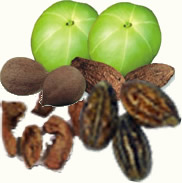
The herb of Triphala is one of the most popular healing herbs on the planet, with millions per year worldwide taking it in some way to cure their ills. The main reason for its popularity, besides its ready availability wherever you happen to be, is that it aids recovery from bowel complaints and lowers blood and cholesterol levels primarily, which are all afflictions that many of us fall victim to at some point in our lives.
Triphala should not necessarily be treated as a healing power rather more a preventive one and as a promoter of good health and general well being. A regular intake, maybe as little as twice a week, of Triphala capsules or powder should be enough to keep any major disorder related to the bowel or general digestive system at bay.
This is because the natural Triphala plant extract contains an exceptionally high nutrient count which enables it to perform an almost uniquely superb cleansing and detoxification upon the inner organs, bowel area, digestive systems and all other functions of the body as it dissolves into the bloodstream. If you wish you can think of it giving your insides a very good valeting!! And if you did that twice a week think how spotless your car would be. Now think how cleansed and healthy your body will be after a regular dose of Triphala.
Triphala is a purgative and so makes a pretty good laxative. It has special value in its native India, as not only is it a highly recommended herbal supplement in Ayurvedic philosophy and is part of many of its courses leading to good health, but it also serves as a laxative for vegetarians worldwide but particularly Indian Hindus, as its soft constitution is more suited to these digestive systems than the more commonly found harsher textured laxatives.
This is because Triphala is considered a lubricating bulk laxative, which unlike other laxatives have no chance of possibly damaging the gall bladder when consumed as it has more nutrional value. As a result it acts as a sponge in the bladder gradually squeezing the waste matter outwards, rather than putting the sufferer through a more direct and probably more troubling and taxing purging.
Because of its fine constitution that is easy on the body when ingested, more of a glide from a soft feather duster rather than a harsh scrub from a de-scaler upon your vital organs and also because of its detoxification and cleansing properties, Triphala isn't just prescribed as a laxative but also as a blood purifier. Within it contains particularly high and exceedingly high vitamin C content, linoleic oil and other natural tonic. This magical combination warms the blood up, which makes your entire circulatory system work in perfect order. This easy flow gets the healthy blood cells into creating enough bile to fight off any invading infection within your body.
It is quite simple, if you don't wish to suffer from bowel complaints, high cholesterol and blood and liver disorders, amongst others, take Triphala regularly and you won't.
Triphala (Digestive Support) is a composite herbal preparation containing equal proportions of the fruits of three myrobalans, Emblica officinalis, Terminalia chebula and Terminalia bellerica. This preparation is known to be a safe hypoglycemic agent. Triphala prevents aging, imparts immunity and improves mental faculties. It helps to detoxify the liver, restore digestion and purify blood. Triphala is widely used in a large number of medicinal preparations. It is also a laxative that rejuvenates the membrane lining the digestive tract and contributes to effective cleansing of the colon, a key condition in Ayurveda to maintaining optimum health.
Amla
Scientific Name : Emblica officinalis Family : Euphorbiaceae Common Name : Amala, Amlaki, Amalaka, Indian Gooseberry, Part Used: Fruit Habit and Distribution : It is found everywhere in Southeast Asia Chemical constituents : The fruit contain high amounts of ascorbic acid (vitamin C). It also contains tannins and colloidal substances, Lipids, Flavonoids, Kaempferol, ellagic acid and gallic acid. Uses: Fresh fruit of Amla (Emblica Officinalis) is refrigerant, diuretic and laxative. Green fruit is exceedingly acid. Fruit is also carminative and stomachic. Dried fruit is sour and astringent. Flowers are cooling and aperient. Bark is astringent. The herb is also aphrodisiac, hemostatic, nutritive tonic, rejuvenative (for Pitta). It increases red blood cell count. It is one of the highest natural source of Vitamin C (3,000 mg per fruit).
Haritaki
Scientific Name : Terminalia chebula Family : Combretaceae Common Name : Hardad, Haritaki, Harada, Aralu Part Used : Seed, Fruit Habit and Distribution : It is native to southern Asia from India and Nepal east to southwestern China (Yunnan), and south to Sri Lanka, Malaysia and Vietnam Chemical constituents: The fruits of Haritaki contains about of an astringent substance which is mixture of tannins, tannic acid, betulinic acid, chebulinic acid, chebulin, chebulic acid, luteoic acid and other organic acids, beta-sitosterol and sugars.
Bahera
Scientific Name : Terminalia bellerica Family : Combretaceae Common Name : Beleric, Bastard myrobalan, Bahera, Boira Part Used : Fruit Habit and Distribution : It is common on plains and lower hills in Southeast Asia Chemical constituents : Fruits contain tannins which is composed of gallotannic and ellagitannic acids,ellagic acid and gallic acid, galloyl glucose, chebulagic acid and phyllemblin. They have also been reported to contain mannitol, beta-sitosterol, resins, hydrocarbons, and sugars, etc.